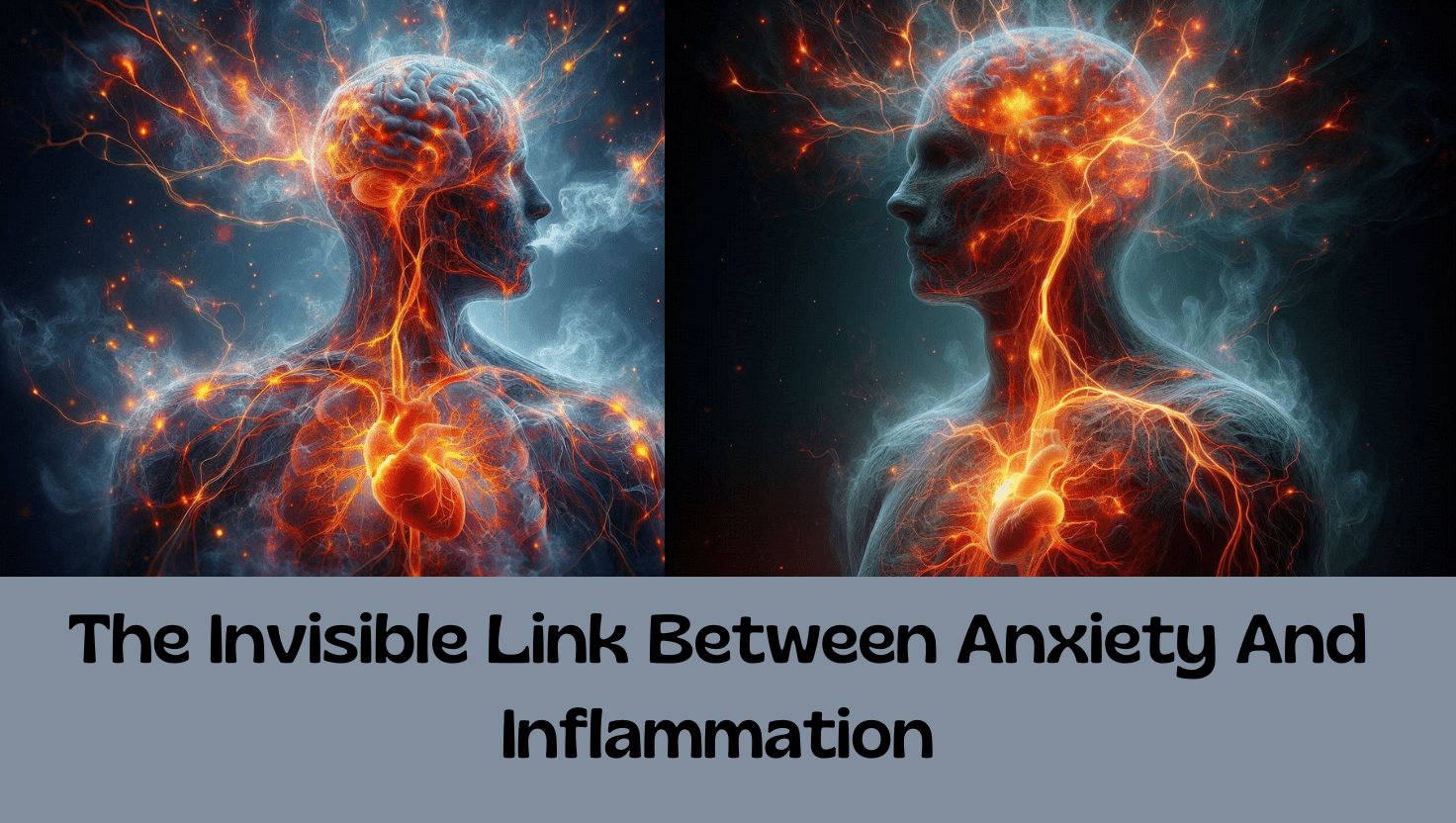Here, we are talking about how anxiety and inflammation are interconnected and affect the body both externally and internally.
Imagine lying awake at 3 a.m., your mind racing about work deadlines, family responsibilities, or that awkward conversation you had three years ago. Your heart pounds, your muscles tense, and your stomach churns. We’ve all felt anxiety’s grip, but what if this mental turmoil isn’t just “in your head”? What if it’s silently sparking fires inside your body?
Mounting research reveals a startling connection: chronic anxiety doesn’t just weigh on your mind—it fuels systemic inflammation, a hidden driver of diseases from arthritis to heart conditions. Let’s unravel this invisible link and explore how calming the mind might heal the body.
The Biology of Stress: When Your Body Sounds the Alarm
To understand how anxiety stokes inflammation, we need to revisit Biology 101. When you sense danger (real or imagined), your brain activates the “fight-or-flight” response. The hypothalamus triggers a cascade of hormones, including cortisol and adrenaline, preparing you to outrun a predator—or survive a stressful Zoom call.
This system, known as the HPA axis, is brilliant in short bursts. But when anxiety becomes chronic, the HPA axis gets stuck in overdrive. Cortisol, which normally dampens inflammation, floods the body so persistently that cells stop responding to it—a phenomenon called “cortisol resistance.” Meanwhile, stress hormones like norepinephrine rev up the production of cytokines, proteins that signal inflammation.
“Think of it like a car alarm that won’t turn off,” explains Dr. Lisa Miller, a psychoneuroimmunologist at Columbia University. “Chronic anxiety keeps your immune system on high alert, mistaking everyday stress for a physical threat.”

Anxiety’s Inflammatory Spiral: A Vicious Cycle
Here’s where it gets eerie: inflammation isn’t just a result of anxiety—it can worsen it. Studies show that elevated cytokines can cross the blood-brain barrier, disrupting mood-regulating neurotransmitters like serotonin. This creates a feedback loop: anxiety fuels inflammation, which deepens anxiety, and so on.
Real-Life Example: Take Sarah, a 28-year-old teacher with generalized anxiety disorder. After years of panic attacks and sleepless nights, she developed psoriasis—an autoimmune condition linked to inflammation. “My skin felt like it was mirroring my mind,” she says. Blood tests revealed high levels of C-reactive protein (CRP), a key inflammation marker common in anxious individuals.
Sarah’s story isn’t unique. A 2021 meta-analysis in JAMA Psychiatry found that people with anxiety disorders have 30-50% higher CRP levels than non-anxious peers. Another study linked childhood trauma (a known anxiety trigger) to elevated inflammation decades later.
The Social Side of Stress: Loneliness Fuels the Fire

Humans are wired for connection, but loneliness and social isolation are modern epidemics—and they’re potent drivers of anxiety and inflammation. Studies show that feeling socially disconnected increases IL-6 and TNF-alpha, two pro-inflammatory cytokines, by up to 25%.
Why? Evolutionary biologists suggest that in our ancestral past, social rejection signaled physical danger (e.g., being ousted from a tribe). Today, loneliness triggers the same primal stress response, keeping inflammation simmering.
Case in Point: After retiring, Tom, a 68-year-old widower, became increasingly isolated. His anxiety spiked, and he developed persistent joint pain. Bloodwork showed elevated inflammation markers. His doctor recommended joining a community gardening group. Within months, Tom’s pain eased, and his mood lifted. “The combination of socializing and being outdoors was like a reset button,” he says.
The Hidden Role of “Childhood Trauma”

Early life stress casts a long shadow. Adults who experienced childhood trauma (abuse, neglect, or household dysfunction) are 3x more likely to develop autoimmune diseases and 2x as likely to struggle with chronic inflammation, per a landmark 2023 study in Nature Mental Health.
Trauma alters the developing brain’s stress response systems, making them hypersensitive. This “biological embedding” primes the body for lifelong inflammation. Dr. Nadine Burke Harris, a pediatrician and trauma expert, explains: “Adverse childhood experiences don’t just affect behavior—they rewrite our physiology.”
Real-Life Example: Lila, a 40-year-old artist, endured emotional abuse as a child. By her 30s, she battled both generalized anxiety and fibromyalgia, a condition linked to neuroinflammation. Therapy focused on trauma processing, combined with anti-inflammatory dietary changes, helped her reclaim her health. “Understanding my past helped me heal my present,” she says.
Environmental Effects: When the World Feels Hostile
External factors—from air pollution to noise—can amplify anxiety and inflammation. For example:
-
Air Pollution: Fine particulate matter (PM2.5) not only damages lungs but also increases systemic inflammation and anxiety risk.
-
Chronic Noise: Living near loud traffic correlates with higher cortisol and CRP levels.
-
Toxic Workplaces: High-demand, low-control jobs (e.g., healthcare, retail) are linked to 72% higher inflammation markers compared to lower-stress roles.
“Our environments are invisible stressors,” says Dr. Arline Bronzaft, an environmental psychologist. “They keep the body in a low-grade state of alarm, which wears down both mental and physical health over time.”
When Inflammation Strikes: From Aching Joints to Aching Hearts

So, what’s the harm in a little inflammation? Acute inflammation heals wounds and fights infections. But when it becomes chronic, it’s like a slow-burning fire damaging tissues over time.
-
Autoimmune Diseases: Conditions like rheumatoid arthritis and lupus often flare under stress.
-
Cardiovascular Risks: Inflammation erodes blood vessels, raising heart attack and stroke risks.
-
Metabolic Havoc: Chronic inflammation is tied to insulin resistance, a precursor to diabetes.
Case in Point: James, a 45-year-old veteran with PTSD, struggled with nightmares and hypervigilance. Despite a healthy diet, he developed coronary artery disease. His cardiologist wasn’t surprised: “Stress-induced inflammation can be as harmful as smoking,” she told him.
Ways to Reduce Anxiety and Inflammation
The good news? Tackling anxiety can douse inflammatory fires. Here’s how:
-
Mindfulness & Meditation: Studies show mindfulness reduces both anxiety and CRP levels. Even 10 minutes daily can help “reset” the HPA axis.
-
Move Your Body: Exercise lowers cytokines and boosts endorphins. Yoga, in particular, blends movement with stress relief.
-
Anti-Inflammatory Diet: Omega-3s (found in fish, walnuts), antioxidants (berries, leafy greens), and probiotics (yogurt, kimchi) combat inflammation.
-
Sleep Hygiene: Poor sleep spikes cortisol. Aim for 7-9 hours nightly—a non-negotiable for mental and physical health.
-
Therapy: Cognitive-behavioral therapy (CBT) rewires anxious thought patterns, indirectly cooling inflammation.
“It’s about treating the whole person, not just the mind or body,” says Dr. Rachel Abrams, author of BodyWise. “Small, consistent changes can disrupt the anxiety-inflammation loop.”
Healing From the Inside Out

The link between anxiety and inflammation isn’t a life sentence—it’s a roadmap. By addressing triggers at multiple levels (psychological, biological, social, and environmental), we can extinguish the fires burning beneath the surface.
As Sarah puts it after adopting meditation and dietary changes: “My skin cleared up, but more importantly, I feel like I’ve reclaimed control.” In a world that often dismisses anxiety as “overthinking,” recognizing its physical toll is the first step toward healing.
After a decade of battling anxiety and eczema, 32-year-old software engineer Raj adopted a “whole life” approach: weekly therapy, daily walks in the park, and cutting out processed foods. Within six months, his skin cleared, and his panic attacks vanished. “I stopped seeing my mind and body as separate,” he says. “They’re teammates, not enemies.”
So the next time stress creeps in, remember: calming your mind might just be the best medicine your body ever receives.
Now Your Turn: Rewriting the Story
The science is clear: anxiety isn’t “just in your head,” and inflammation isn’t “just in your body.” They’re intertwined threads in the tapestry of health. Whether it’s rebuilding your microbiome, nurturing social ties, or simply breathing deeply, every small step toward calm is a step toward cooling inflammation.
As researcher Dr. Esther Sternberg writes in Healing Spaces: “The body whispers before it screams. Learning to listen—and respond—is the art of healing.”
So we can say that-
Anxiety and inflammation are interconnected to each other- A reminder that the mind and body aren’t separate entities but parts of an intricate whole. By addressing stress holistically, we don’t just soothe our minds; we protect our bodies from invisible threats.
Frequently Asked Questions (FAQs)
Q. Can anxiety actually cause inflammation in the body?
A. Yes, Chronic anxiety triggers the release of stress hormones like cortisol and adrenaline, which dysregulate the immune system over time. Studies show prolonged stress leads to “cortisol resistance,” where cells stop responding to its anti-inflammatory signals. This results in elevated cytokines (inflammatory proteins) linked to conditions like arthritis and heart disease.
Q. How do I know if my physical symptoms are from anxiety or inflammation?
A. Anxiety often causes immediate symptoms (racing heart, sweating), while inflammation manifests as persistent issues like joint pain, fatigue, or skin flare-ups. Blood tests for markers like C-reactive protein (CRP) or IL-6 can confirm inflammation. If symptoms overlap, consult a doctor to rule out autoimmune or metabolic conditions.
Q. Can reducing stress reverse inflammation?
A. Partially. Mindfulness, exercise, and therapy can lower stress hormones and cytokines.
For example, a 2020 study found 8 weeks of meditation reduced CRP levels by 20%. However, severe inflammation (e.g., autoimmune disorders) may require medical treatment alongside lifestyle changes.
Q. What foods fight both anxiety and inflammation?
A. Focus on:
- Omega-3s (salmon, walnuts): Reduce cytokines and support brain health.
- Probiotics (yogurt, kimchi): Improve gut-brain axis function.
-
Antioxidants (berries, dark leafy greens): Combat oxidative stress.
Avoid processed sugars and trans fats, which spike inflammation and worsen mood swings.
Q. Is inflammation from stress permanent?
A. Not necessarily. While chronic stress can cause long-term damage, interventions like therapy, anti-inflammatory diets, and sleep hygiene can repair the body. For example, a 2022 study showed trauma-focused therapy reduced inflammation markers in PTSD patients by 30% within 6 months.


2 thoughts on “The invisible Link between anxiety and inflammation – when stress gets under your skin”